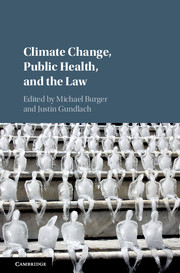Book contents
- Climate Change, Public Health, and the Law
- Climate Change, Public Health, and the Law
- Copyright page
- Contents
- About the Contributors
- Foreword
- Part I The Context
- Part II Cross-Cutting Issues
- Part III Impacts and Interventions
- 7 Heat
- 8 Oceans and Coasts
- 9 Infectious Disease
- 10 Food Systems
- 11 Migration
- Part IV Interplay with International & Domestic Environmental Law
- Index
8 - Oceans and Coasts
from Part III - Impacts and Interventions
Published online by Cambridge University Press: 05 October 2018
- Climate Change, Public Health, and the Law
- Climate Change, Public Health, and the Law
- Copyright page
- Contents
- About the Contributors
- Foreword
- Part I The Context
- Part II Cross-Cutting Issues
- Part III Impacts and Interventions
- 7 Heat
- 8 Oceans and Coasts
- 9 Infectious Disease
- 10 Food Systems
- 11 Migration
- Part IV Interplay with International & Domestic Environmental Law
- Index
Summary
Coastal areas are some of the first areas to require climate change adaptation, a result of sea-level rise, exacerbated coastal storms, changing coastal chemistry and biodiversity, and increasing human populations and infrastructure. Coastal adaptation should include a public health perspective, because climate change is simultaneously increasing the risks of coastal disasters, toxic contamination, loss of water supply, and disease. Given the multiple threats facing coastal areas, a public health response must arise from multiple sectors simultaneously, from building codes and land use planning to more traditional disaster and disease preparedness to more finely tuned application of environmental and natural resources laws.
This chapter examines climate change’s impacts on the oceans and coasts, then focuses on two types of coastal adaptation. Increasing numbers of increasingly severe coastal storms pose one set of disaster-type public health risks to coastal communities, and this chapter examines prudent disaster preparedness actions to reduce them. However, coasts are also subject to longer-term and often more subtle public health threats as a result of rising seas and warming temperatures, requiring overlapping but distinct public health responses to adapt to salinization and new disease threats.
- Type
- Chapter
- Information
- Climate Change, Public Health, and the Law , pp. 204 - 240Publisher: Cambridge University PressPrint publication year: 2018



